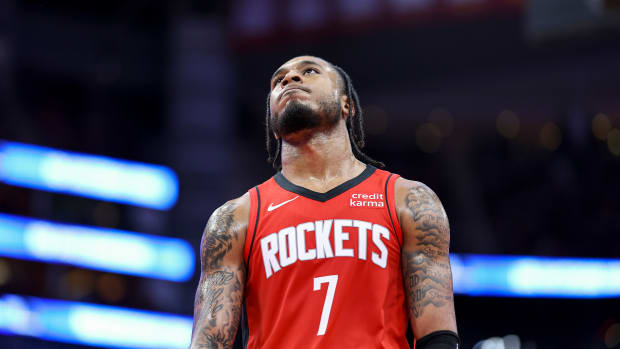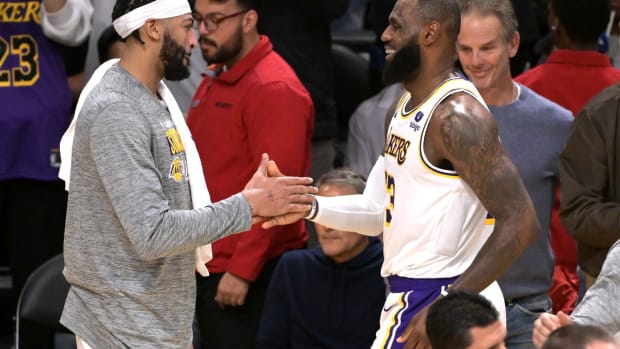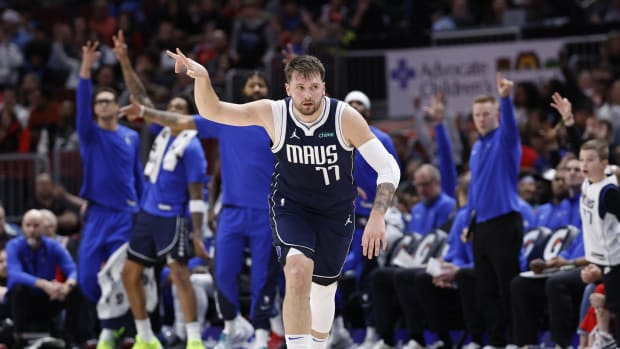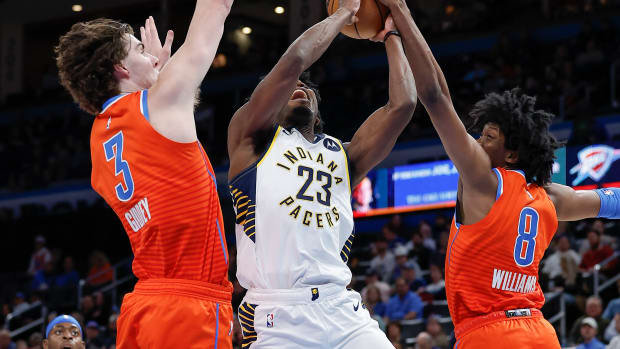The Jazz Don't Need to Be a Superteam
Over the past few years, the Jazz had internalized the friction of modern basketball. A team that ranked seventh in the league in three-point rate and 10th in three-point percentage still found itself in need of perimeter shooting at times. Creating space on the floor is a three-dimensional problem; helpful as it is to have standout shooters, it’s their arrangement in relation to one another that puts opponents in a state of tension. Show them a point guard like Ricky Rubio—who doesn’t often want to shoot and isn’t particularly good at it—and they will find some release. Run Derrick Favors at power forward alongside Rudy Gobert, and good teams will effectively neutralize him.
That neither Rubio nor Favors will play in Utah next season is a deliberate choice. Their replacements are not just better, but unmistakably different. Trading Jae Crowder, Grayson Allen, Kyle Korver, and two first-round picks for Mike Conley made sense because he would present a threat in ways Rubio never could. Letting Favors go—and finding him a suitable new home—was a practical precursor in the signing of Bojan Bogdanović, a 6'8" forward who will, at long last, stretch Utah’s offense to the fullest. The contrast is the point. For all the promising elements at work for the Jazz, any real path forward demanded greater dynamism.
Utah found it without having to reimagine the systems behind its offense and defense. Even from across the league, Bogdanović and Conley were showcasing their fit for Quin Snyder’s offense. Both will feel cozy in its dribble hand-offs and right at home in the way it moves. Each will simply give more punch to every action they’re involved in. Go under a screen for Conley or stray away from Bogdanović at your own peril. Everything that Utah runs is about movement, and over the course of the summer they landed one of the NBA’s most dangerous shooters on the move and one of its soundest decision-makers within the flow of an offense. Neither is a superstar, but both will bring a great deal of complexity to what was already a 50-win team.
In the gradual evolution of the Jazz, Favors was the clearest vestige. There were times when having a balanced, more traditional power forward played as a targeted strength; it’s easy to forget that it was Favors who exploited Carmelo Anthony so fully in the 2018 playoffs, bringing the end of Oklahoma City’s season and possibly the end of Anthony’s career. Some smaller forwards had no answer for his strength inside, his short-roll game, and his work on the glass. Given enough trials, however, it became clear that Favors and Gobert were a largely conditional fit at a time when most of the West’s best playoff teams existed outside that condition.
Utah was not blind to this. The need for a stretch option is what led the Jazz to draft Trey Lyles in 2015 and to trade for Crowder in 2018. Neither worked out quite as intended. Lyles often seemed to be in over his head and Crowder (who shot 32.8% from three over a season and change with the Jazz) was more of a spacer in theory than in practice. But there are two kinds of stretch fours in the NBA: those a team acquires and those a team makes. So Utah dabbled in stretching Favors out to the corners, an arrangement that never felt fully comfortable. It took years before he would even attempt threes with any frequency, and it could take years more before it becomes an actual part of his game.
The time had come to move on. Lineups featuring Favors and Gobert got wrecked by the Rockets in consecutive postseasons, making it clearer than ever that something would have to change. One of the best defenses in the league strained against its own size. Donovan Mitchell ran repeatedly (and fruitlessly) into walls of defenders. Joe Ingles went cold, and Utah’s fate was sealed. The need for better shot creation and better spacing had never been so stark. Bogdanović alone is an expression of both. It’s telling that rather than sign or trade for a more textbook stretch four, the Jazz signed a natural wing to a four-year, $73 million contract. Bogdanović is a shooter and a forward, but one who weaves around the floor like Kyle Korver or Klay Thompson.
This, definitively, is not a stretch four:
It’s something else entirely. Bogdanović was the scorer who allowed Indiana to make do without Victor Oladipo for the better part of three months last season: a flexible shooter who can be moved around the floor in all sorts of ways without throwing off his rhythm. Sell out on his shot, and Bogdanović can attack the basket to keep the offense in motion. Rather than idle on the perimeter to catch and shoot, everything about Bogdanović’s game draws on and builds fluidity. How opponents attempt to contain him will be fascinating. If teams guard Bogdanović with their own fours, they’ll largely be submitting a defender to a job for which he’s poorly equipped. If they choose to guard Ingles with their power forward instead, Utah could have him run pick-and-rolls to again push the defense out of sorts. Neither forward is a star, but neither is exactly conventional or predictable, either.
More than anything, that’s what Utah needed: another player to put opponents in a bind. Distract a defense even slightly and Mitchell’s solo work can proceed more smoothly. Run Bogdanović off a screen and his defender—intended to tag Gobert as he rolls down the lane—might freeze. This isn’t a superteam, but the Jazz do have three players who were the primary option for their respective teams last season. Success could be as simple as triangulating between them.



































